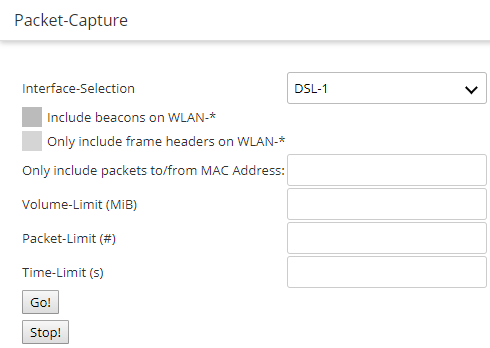The function offers you a simple way to capture data packets from different interfaces and then analyze them with a program such as Wireshark.

To specify the output file the following general menu items are available:
- Interface selection
- Use this drop-down menu to choose the interface that you want to capture data packets for.
- Include beacons on WLAN-*
- Enable this option to capture beacon information in addition to the data packets if the selected interface is a WLAN interface.
- Include packet headers only on WLAN-*
- Enable this option to limit the capture of data packets to the packet header if the selected interface is a WLAN interface.
- Only include packets to/from MAC address
- If you only want to record data packets for a particular physical address within the selected interface, you can specify it here.
- Volume limit (MiB)
- Enter the maximum volume of the recorded packets in Mebibytes.
- Packet limit (#)
- Here you can set the maximum number of packets to be recorded.
- Time limit (s)
- Enter the maximum time in seconds, after which the recording ends.
After you set the parameters and click on Go! you create a file that you can save anywhere and open with Wireshark, for example. After a certain period of time (depending on the connection speed), a window opens for you to save the generated files. You can now save the file locally with the suffix *.cap. By default, the file name is composed of the description and interface associated with the device for which the data packets were recorded (e.g. MyDevice-LAN-2.cap). You can change the name when saving or later.
Flexible WLAN capture format
A variety of different formats are available to you for storing WLAN packet-capture data. ).
